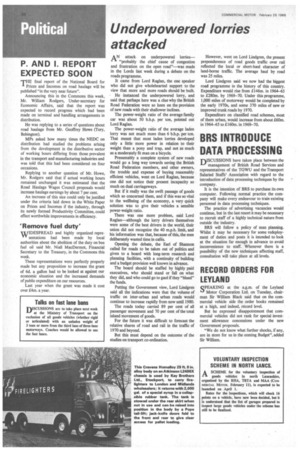Underpowered lorries attacked
Page 38

If you've noticed an error in this article please click here to report it so we can fix it.
AN attack on underpowered lorries' "probably the chief cause of congestion and frustration on the open road"—was made in the Lords last week during a debate on the roads programme.
It came from Lord Raglan, the one speaker who did not give wholehearted support to the view that more and more roads should be built.
He instanced the underpowered lorry, and said that perhaps here was a clue why the British Road Federation were so keen on the provision of new roads with their shallower inclines.
The power-weight ratio of the average family car was about 50 b.h.p. per ton, pointed out Lord Raglan.
The power-weight ratio of the average laden lorry was not much more than 6 b.h.p. per ton. That meant that most laden lorries developed only a little more power in relation to their weight than a pony and trap, and not as much as a moderately fit man on a bicycle.
Presumably a complete system of new roads would go a long way towards saving the British Road Federation members, and other owners, the trouble and expense of buying reasonably efficient vehicles, went on Lord Raglan, because one did not notice their present incapacity so much on dual carriageways.
But if it really was the swift passage of goods which so concerned them, and if this was so vital to the wellbeing of the economy, a very quick solution was to give their vehicles a sensible power-weight ratio.
There was one more problem, said Lord Raglan—although the lorry drivers themselves were some of the best drivers in the world, their union did not recognize the 40 m.p.h. limit, and his information was that, because of this, the men deliberately wasted time in cafes.
Opening the debate, the Earl of Shannon called for roads to be taken out of politics and given to a board with long-term research and planning facilities, with a continuity of building and a budget provision well known in advance.
The board should be staffed by highly paid executives, who should stand or fall on what they did, and who could go to gaol if they "blued" the funds.
Putting the Government view, Lord Lindgren said all the indications were that the volume of traffic on inter-urban and urban roads would continue to increase rapidly from now until 1980.
The roads today carried 89 per cent of all passenger movement and 70 per cent of the total inland movement of goods.
For the future it was difficult to forecast the relative shares of road and rail in the traffic of 1970 and beyond.
But this must depend on the outcome of the studies on transport co-ordination. However, went on Lord Lindgren, the present preponderence of road goods traffic over rail reflected the local or short-haul character of land-borne traffic. The average haul by road was 25 miles.
Lord Lindgren said we now had the biggest road programme in the history of this country. Expenditure would rise from £146m. in 1964-65 to £280m. by 1969-70. Under this programme, 1,000 miles of motorway would be completed by the early 1970s, and some 370 miles of new or improved trunk roads by 1970.
Expenditure on classified road schemes, most of them urban, would increase from about £60m. in 1964-65 to £160m. in 1969-70.




























































































































